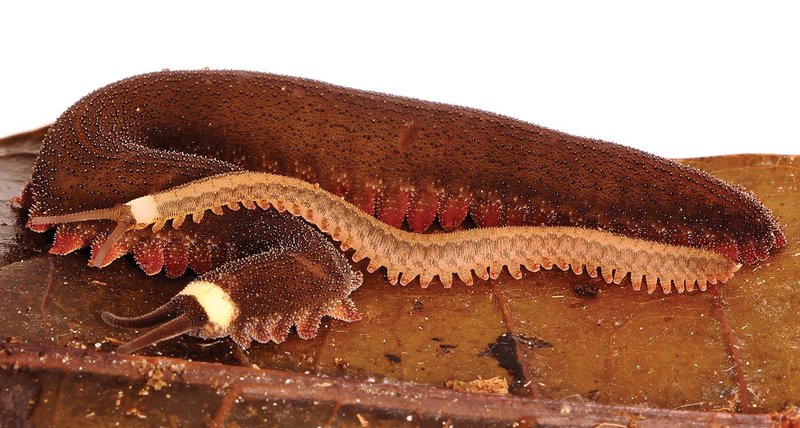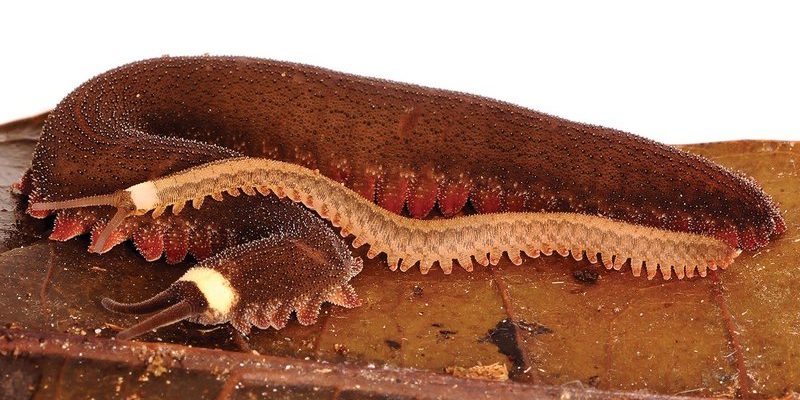
Teaching about velvet worms isn’t just about their unique looks; it’s about using them as a gateway to broader environmental concepts. Think of velvet worms as nature’s ambassadors, helping us dive into discussions on biodiversity, conservation, and the interconnectedness of life on Earth. They remind us that every tiny creature has its story to tell and its place in the grand tapestry of life.
What Are Velvet Worms?
Velvet worms, part of the phylum Onychophora, are a group of soft-bodied, segmented creatures that look like a mix between a caterpillar and a slug. Found primarily in humid forests, they have a fascinating evolutionary history, dating back over 500 million years. These critters have a squishy, velvety texture, which is how they got their name. They can be a bit shy, often hiding under leaf litter or among rocks, but if you’re patient, you might catch a glimpse of their unique behaviors.
These creatures are most known for their *slimy hunting technique*. Velvet worms have specialized glands that produce a gluey substance that they shoot at their prey, typically insects. Once ensnared, they devour their meals using sharp jaws. This hunting method is not just cool; it also showcases the delicate balance of predator and prey in the ecosystem.
The Role of Velvet Worms in Ecosystems
Here’s the thing: velvet worms may be small, but they have a big role in their environments. As predators, they help control insect populations, ensuring that no single species dominates the ecosystem. This balance is vital because it supports a diverse range of organisms, from plants to larger animals that rely on insects for food.
Moreover, velvet worms contribute to soil health. As they move through the leaf litter and soil, they aerate it, breaking down organic material. This process enriches the soil, promoting plant growth and maintaining the health of their forest habitats. Without creatures like velvet worms, the ecosystem’s health could decline.
In environmental education programs, showcasing these roles can help students understand interdependence in nature. By learning about velvet worms, they can grasp broader concepts of ecosystem dynamics, conservation, and sustainability.
Using Velvet Worms in Environmental Education
Incorporating velvet worms into environmental education programs can be both fun and enlightening. For starters, they can serve as an engaging entry point to discussing biodiversity. Students often connect with unusual animals, and velvet worms’ peculiar traits can spark curiosity and questions.
One effective way to introduce them is through hands-on activities, like field trips to local forests or nature reserves. Observing these creatures in their natural habitats provides an unforgettable experience, and it encourages active discussions about their environment. It’s a chance for students to appreciate the beauty and complexity of life forms that might go unnoticed otherwise.
Additionally, using *visual aids*—like videos or images of velvet worms in action—can enhance the learning experience. You can even bring in real-life data on their populations and habitats, fostering a deeper understanding of their conservation status and what we can do to protect them.
The Importance of Conservation
Conservation is at the heart of environmental education, and velvet worms can highlight the need to protect biodiversity. Many velvet worm species face threats due to habitat loss, pollution, and climate change. By discussing these issues, educators can inspire students to take action, whether it’s through advocacy, volunteering, or personal lifestyle changes.
Including velvet worms in lessons about conservation can also show students the direct impacts of their choices. For instance, they can learn how reducing plastic use or conserving water can positively affect local habitats where velvet worms thrive.
Furthermore, real-world examples of successful conservation efforts involving velvet worms can ignite hope and motivation in students. When they see that positive change is possible, they’re more likely to engage in efforts that support the environment.
Creative Projects and Activities
Engaging students with creative projects around velvet worms is a fantastic way to reinforce learning. Here are a few ideas:
- Art Projects: Have students create illustrations or sculptures of velvet worms, incorporating facts they’ve learned into their art pieces.
- Research Presentations: Encourage groups to research different species of velvet worms, their habitats, and their ecological roles and then present their findings.
- Field Journals: During field trips, ask students to keep journals documenting what they observe, including notes on the ecosystems where velvet worms live.
These activities not only solidify knowledge but also help students express their understanding in various ways. Plus, they foster teamwork and communication skills, which are crucial in environmental advocacy.
Incorporating velvet worms into environmental education programs isn’t just about teaching facts; it’s about fostering a connection to nature and understanding the importance of every creature, big or small. By using these fascinating organisms as a teaching tool, we can inspire future generations to appreciate biodiversity and actively participate in conservation efforts.
As we face global environmental challenges, nurturing a sense of responsibility and wonder in young minds is more important than ever. Velvet worms remind us that even the tiniest beings have significant roles in Earth’s story. So, let’s embrace the lessons they teach us and work together to protect our planet for all its inhabitants.

